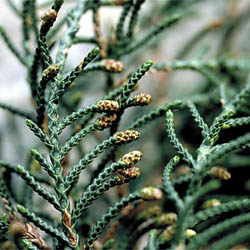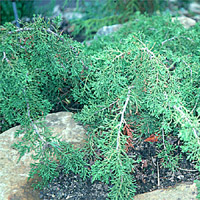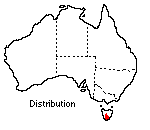Diselma archeri
 |
 |
Cheshunt Pine
In its natural environment, this Tasmanian conifer grows into a small compact tree, sometimes reaching 6 m in height. It rarely reaches this size in the home garden, where it has been reported to form a bushy shrub up to 2 m tall in ten years.
 Diselma
archeri has minute, scale-like, deep green leaves, closely pressed against
and concealing the stem, giving the branches a four-sided appearance. Being
a dioecious conifer, the male and female cones are borne on separate plants. Both types
of cone are small (2-6 mm) and solitary, developing on the ends of the branches.
Each female cone produces up to two small winged seeds.
Diselma
archeri has minute, scale-like, deep green leaves, closely pressed against
and concealing the stem, giving the branches a four-sided appearance. Being
a dioecious conifer, the male and female cones are borne on separate plants. Both types
of cone are small (2-6 mm) and solitary, developing on the ends of the branches.
Each female cone produces up to two small winged seeds.
Though it is not yet commonly grown, this plant is quite tolerant of cultivation, growing well in composted soil. It is frost tolerant and can be planted in a range of positions from full sun to deep shade. Adequate moisture is the most important requirement for this species, particularly in spring and summer.
Although it is possible to raise plants from seed, these are often difficult to obtain as the small seed is shed rapidly by the plant and therefore proves difficult to collect. The easiest method of propagation is from cuttings taken in either spring or autumn, using 40-50 mm long semi-ripe tips of vigorous shoots, although older or harder material will also strike quite well. The cuttings are prepared by cleanly removing side branchlets from the base. They can then be inserted for one-half to two-thirds of their length in a rooting medium consisting of one part fine grade peat moss to two parts coarse, washed river sand by volume.
The use of rooting hormones, misting or soil heating is not essential, though particular attention must be paid to adequate watering. At the Australian National Botanic Gardens, cuttings taken in autumn have rooted in four to five months with 90% success.
There have been no reports of pest or disease infestations on this species. Plants can be seen growing in the Tasmanian flora section of the Gardens, but the natural soil of this area does not promote optimum growth.
Diselma archeri can be compared with Microcachrys tetragona. They grow in similar environments in Tasmania and require similar gowing conditions.
Text by Stephen Hughes, ANBG (1981)
Name meaning: Diselma archeriDiselma - from the Greek, di, two, and selma, meaning upper, alluding to the two fertile scales in the cone; archeri - named after the collector of the species, William Archer (1820-1874), Fellow of the Linnaean Society, architect, and Member of Parliament for Deloraine in Tasmania. |
![An Australian Government Initiative [logo]](/images/austgovt_brown_90px.gif)

